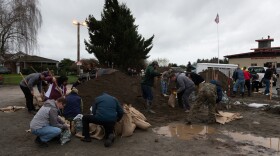Cement is the source of as much as 10% of all carbon dioxide emissions worldwide. That’s according to materials scientists at the University of Washington who are aiming to reduce that carbon footprint, by adding seaweed to the mix.
Eleftheria Roumeli is an assistant professor of mechanical engineering at UW. Her latest findings showed that ordinary sea lettuce from the Salish Sea could be air dried, ground up and mixed into cement. They used green algae grown by the Pacific Northwest National Lab.
Without any extra treatment, the team ran compression tests to confirm that the seaweed-fortified concrete retained construction-grade strength. The addition of biomass reduced its global warming potential by 21%.
“That is a fact. What we're trying to do now is trying to understand is what is the feedstock flexibility,” Roumeli said.
“Can I actually not use that specific one, but can I use the cousin or the grandparent of that, if you will?”
She said finding effective biomass substitutes locally will be a key for sustainability, all around the world. Different communities have different kinds of available materials.
Roumeli’s team is now testing several other species of seaweeds that grow locally in the Salish Sea region as well as some from Hawaii, with an eye toward maximizing the benefits of their use.
They’re imagining harvesting invasive species — think Sargassum, an abundant brown algae — or beneficial seaweeds like kelp that absorb carbon and provide wildlife habitat, while they’re growing. Another possible feedstock: food waste.
Testing the viability and strength of all these materials is complex and time consuming, but the team got help from Microsoft. The software giant’s research arm provided funding as well as a machine-learning algorithm to speed up the design and testing process.
Roumeli’s lab is a hub for research on other sustainable substitutes made from biological sources including gels, adhesives, bioplastics and flame retardants. But she said the outsized role of cement in the world’s greenhouse gas emissions makes it a priority.
“Cement is the most consumed material on Earth, after water. We just use it a lot because it's so important for civilization, [for] infrastructure and whatnot. And we now know that it's also contributing a lot of greenhouse gasses. Therefore, we do need to think about ways to reduce that,” she said.
The team published its results on seaweed-infused cement last month in the journal Matter.







